Congressional Democrats continued to negotiate and debate within their caucus the shape and contents of their forthcoming domestic spending bill. Meanwhile, a key lawmaker in the House has introduced a resolution to recognize November as National Career Development Month. In addition, the U.S. Department of Education (ED) approved two more state plans as part of the most recent COVID-19 (coronavirus) aid package passed by Congress earlier this Spring.
 House Democrats Revise BBBA and Are Poised to Approve It
House Democrats Revise BBBA and Are Poised to Approve It
On Wednesday, the House Rules Committee unveiled revised text for the Build Back Better Act (BBBA)– $1.75 trillion legislation that would invest in a number of President Biden and Congressional Democrats’ domestic priorities, including Career Technical Education (CTE) and workforce development. As shared last week, this proposal would provide $600 million for the Strengthening Career and Technical Education for the 21st Century Act’s (Perkins V) basic state grant formula program and $100 million for the law’s Innovation and Modernization competitive grant program. In addition, the proposal would provide new funding for several other programs of interest including apprenticeship expansion, “Grow Your Own” teacher and school leader development programs, and additional funding for the Federal Communications Commission’s (FCC) Emergency Connectivity Fund among other initiatives.
Following the release of this draft proposal, Advance CTE and the Association for Career and Technical Education (ACTE) issued a joint statement outlining the organizations’ support for the legislation but calling for the inclusion of Community College and Industry Partnership grant funding. Significantly, this revised version of the BBBA now includes $5 billion for this program. Advance CTE applauds House lawmakers’ acknowledgment of the importance of this proposed investment in the nation’s postsecondary education system and is particularly encouraged to note that certain Area Technical Centers would be eligible to apply for these grants under the current proposal.
Following the release of this revised text, the House Rules Committee met late into the night on Wednesday, teeing up a possible vote on the legislation sometime on Friday, November 5. The measure, along with legislation investing in the nation’s physical infrastructure, are widely expected to pass by a slim margin in the chamber later today (Friday, November 5) although a vote and related debate have not yet started at the time of this writing.
Should this current timeline hold, and with both Chambers out on recess next week, the earliest the BBBA could be taken up by the Senate is sometime during the week of November 15. However, key members of the Democratic caucus, particularly Sen. Manchin (D-WV), have so far been noncommittal regarding their support for the proposal as currently constructed in the House. This likely means that the Senate will make changes to the legislation prior to final passage. It remains unclear what potential changes will be made to the bill in order to garner the Senator’s support. As this process unfolds, Advance CTE will continue to advocate for a robust investment in these programs as part of any final legislative agreement.
CTE Caucus Co-Chair Rep. Langevin Introduces Measure Career Development
On Monday, Rep. Langevin (D-RI) introduced a legislative measure in the House expressing support for designating November 2021 as “National Career Development Month.” The resolution highlights the immense importance of career development activities and its impact, including the work of career counselors, that it has on learners. The resolution also elevates a recent Harris Interactive Poll which found that only 13 percent of those surveyed had received career development support from a school or private counselor, or other career specialists.
ED Approves Two More State ARP Plans
The American Rescue Plan (ARP), passed exclusively by Congressional Democrats earlier this year, authorized $122 billion in additional pandemic aid funding to be disbursed to states and K-12 school districts this past spring. Since that time, ED has distributed two-thirds of this funding to states via a formula detailed in the legislation. The Department held back the remaining third of these funds, however, until states and territories submitted plans detailing how they would make use of these resources to support students as they recover from the impacts of the pandemic.
On Monday, November 4, ED approved two more of these plans, sending these additional funds to California and Colorado. Only five more states, along with Puerto Rico, have yet to have their ARP plans approved. The current status of all state ARP plans, including highlights of plans approved by the Department so far, can be found here.
Steve Voytek, Policy Advisor


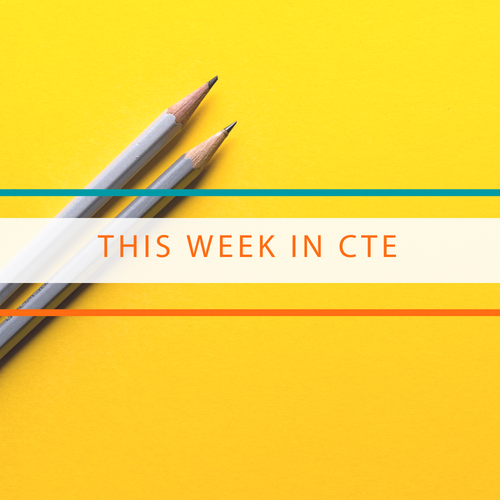 Developed with input from nearly 200 national, state and local education and workforce development leaders and supported by 40 national organizations,
Developed with input from nearly 200 national, state and local education and workforce development leaders and supported by 40 national organizations,  Our Mission
Our Mission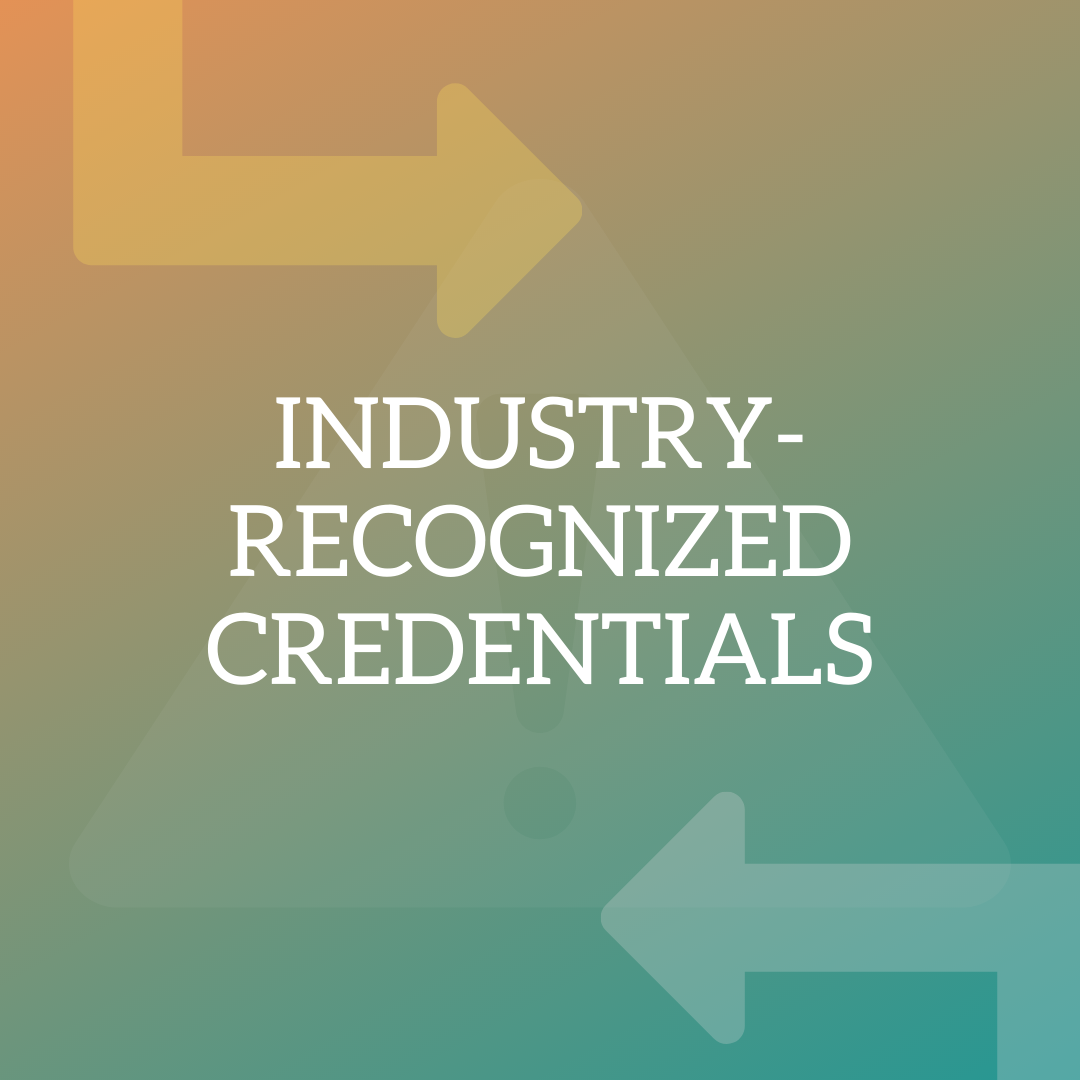 Industry-recognized credentials are an essential component of any high-quality Career Technical Education (CTE) program. They indicate the entry-level competencies learners need in a given career field and signal to employers that an individual is prepared for work. But in the midst of a global pandemic, with nearly every state issuing, to varying degrees, stay at home orders that have resulted in school closures and limited access to testing facilities, how can learners continue to earn industry-recognized credentials?
Industry-recognized credentials are an essential component of any high-quality Career Technical Education (CTE) program. They indicate the entry-level competencies learners need in a given career field and signal to employers that an individual is prepared for work. But in the midst of a global pandemic, with nearly every state issuing, to varying degrees, stay at home orders that have resulted in school closures and limited access to testing facilities, how can learners continue to earn industry-recognized credentials? 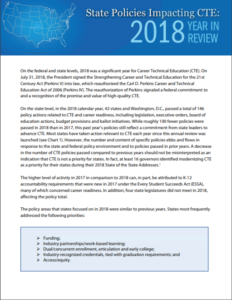 2018 was a significant year for Career Technical Education (CTE) at the federal and state levels. On July 31, 2018, the President signed the Strengthening Career and Technical Education for the 21st Century Act (Perkins V) into law, which reauthorized the Carl D. Perkins Career and Technical Education Act of 2006 (Perkins IV). The reauthorization of Perkins signaled a federal commitment to and a recognition of the promise and value of high-quality CTE. Additionally, at the state level 42 states and Washington, D.C., passed a total of 146 policy actions related to CTE and career readiness, reflecting a commitment from state leaders to advance CTE.
2018 was a significant year for Career Technical Education (CTE) at the federal and state levels. On July 31, 2018, the President signed the Strengthening Career and Technical Education for the 21st Century Act (Perkins V) into law, which reauthorized the Carl D. Perkins Career and Technical Education Act of 2006 (Perkins IV). The reauthorization of Perkins signaled a federal commitment to and a recognition of the promise and value of high-quality CTE. Additionally, at the state level 42 states and Washington, D.C., passed a total of 146 policy actions related to CTE and career readiness, reflecting a commitment from state leaders to advance CTE.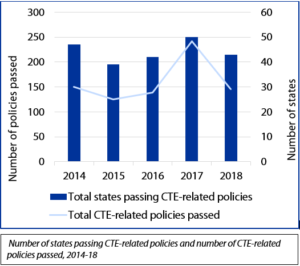 While roughly one hundred fewer policies were passed in 2018 than in 2017, this past year’s policies still reflect a commitment from state leaders to advance CTE. A decrease in the number of CTE policies passed compared to previous years should not be misinterpreted as an indication that CTE is not a priority for states. In fact,
While roughly one hundred fewer policies were passed in 2018 than in 2017, this past year’s policies still reflect a commitment from state leaders to advance CTE. A decrease in the number of CTE policies passed compared to previous years should not be misinterpreted as an indication that CTE is not a priority for states. In fact,  Students were hard at work on their laptops when we walked into the 12th grade environmental science class at Oakland High School. They were writing their senior research papers on different environmental issues in their Bay Area community, the culminating project to graduate from the Environmental Science Academy. One student was writing about the the economic impact of a diminishing bee population, another was looking into the effect of recent wildfires in northern California. And they were more than happy to show off their projects.
Students were hard at work on their laptops when we walked into the 12th grade environmental science class at Oakland High School. They were writing their senior research papers on different environmental issues in their Bay Area community, the culminating project to graduate from the Environmental Science Academy. One student was writing about the the economic impact of a diminishing bee population, another was looking into the effect of recent wildfires in northern California. And they were more than happy to show off their projects.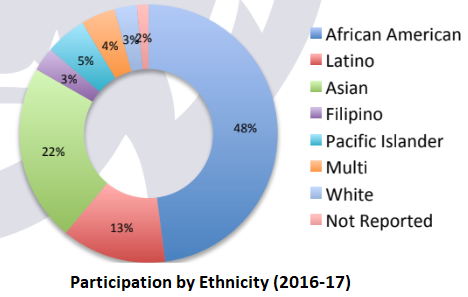 The Linked Learning approach has had a notable impact on O-High student outcomes. In 2018, 81 percent of students graduated and 70 percent enrolled in college within one year. Part of this success is attributable to the high school’s absolute focus on equity. School leaders take special care to ensure that enrollment in each pathway reflects the broader student population, with parity across ethnicity, gender and disability. And in 2010, Oakland Unified launched the Office of African American Male Achievement (AAMA) to support and develop young black males throughout the district. As a result, the African American graduation rate at O-High jumped from 58 percent in 2014 to 90 percent in 2018.
The Linked Learning approach has had a notable impact on O-High student outcomes. In 2018, 81 percent of students graduated and 70 percent enrolled in college within one year. Part of this success is attributable to the high school’s absolute focus on equity. School leaders take special care to ensure that enrollment in each pathway reflects the broader student population, with parity across ethnicity, gender and disability. And in 2010, Oakland Unified launched the Office of African American Male Achievement (AAMA) to support and develop young black males throughout the district. As a result, the African American graduation rate at O-High jumped from 58 percent in 2014 to 90 percent in 2018.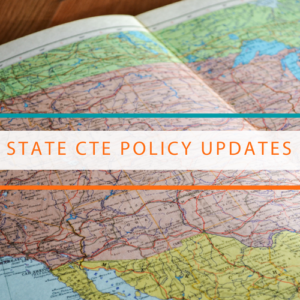 The majority of 2018 state legislative sessions have come to a close. During these legislative sessions, states enacted budgets that illustrate a continued commitment to invest in Career Technical Education (CTE) and opportunities for learners to earn credentials that translate into high-skill, in-demand occupations.
The majority of 2018 state legislative sessions have come to a close. During these legislative sessions, states enacted budgets that illustrate a continued commitment to invest in Career Technical Education (CTE) and opportunities for learners to earn credentials that translate into high-skill, in-demand occupations.